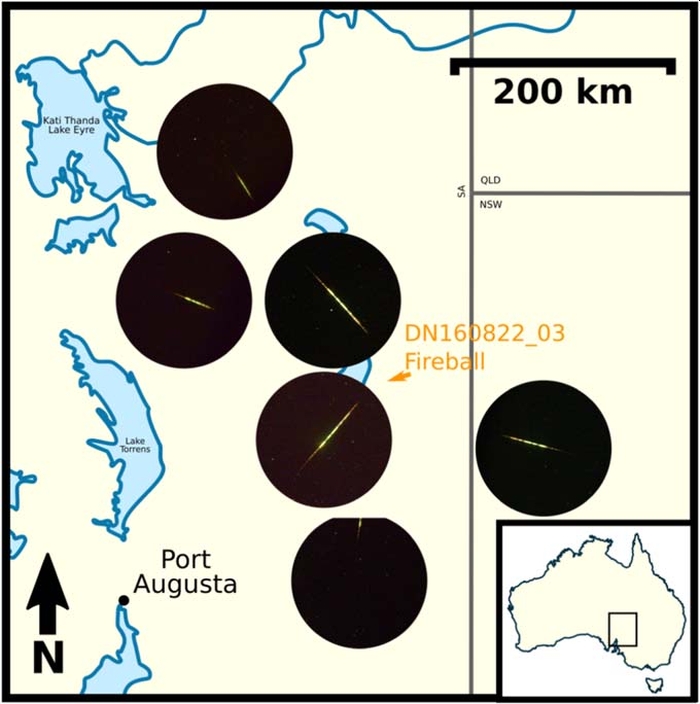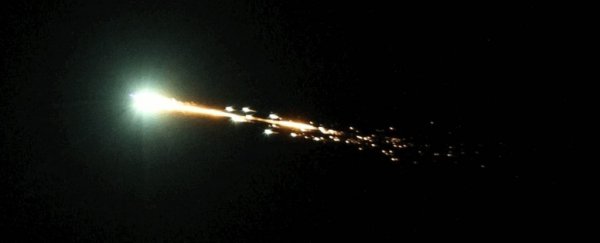Fireballs explode in Earth's atmosphere all the time, usually unremarkably. And a fireball that exploded over the Australian desert in 2016 might have been mistaken for any other bolide, if not for a network of cameras monitoring the sky to search for just such events.
It was thanks to images taken by these cameras - called the Desert Fireball Network - that astronomers were able to ascertain the fireball was no ordinary exploding space rock.
Instead, velocity data revealed the rock had probably been in orbit around Earth before meeting its fiery end; a phenomenon known as a temporarily captured orbiter, or, colloquially, a minimoon.
There are a whole bunch of rocks out there, zipping past Earth, so it stands to reason that some of them are going to penetrate the atmosphere at some point. Most of these end up as bolides - a meteor that explodes in mid-air before it can reach the ground.
(This is because, scientists think, high-pressure air in front of the falling meteor seeps into cracks in the rock, increasing internal pressure and causing the rock to break apart.)
But every now and again, one of these asteroids gets captured in Earth's orbit for a little while. Not often, though: according to a supercomputer simulation published in 2012 involving 10 million virtual asteroids, only 18,000 got captured in Earth orbit.
We're not sure exactly how many asteroids are out there close to Earth. Estimates put the number in the millions, but as of 30 November 2019, only 21,495 have been discovered. That's because they're small and very hard to see - and this detection difficulty also extends to minimoons.
We've detected temporary moons around other planets - Jupiter is particularly adept at minimoon capture - but here on Earth, minimoon detections are extremely rare.
Prior to the 2016 bolide, we'd only seen two Earth minimoons: an asteroid called 2006 RH120, which orbited Earth for about a year from 2006 to 2007; and a bolide in January 2014, with a low velocity that indicated an orbital origin.
 (Shober et al., The Astronomical Journal, 2019)
(Shober et al., The Astronomical Journal, 2019)
With six cameras spanning hundreds of kilometres across the Australian desert, the fireball that streaked across the sky on 22 August 2016 was observed in great detail. The researchers, led by planetary scientist Patrick Shober of Curtin University in Australia, were able to determine the object's velocity (a slow 11 kilometres per second, or 6.8 miles per second) and trajectory (almost vertical).
The slow velocity indicates that the object had been orbiting Earth, and the angle rules out satellite debris. Based on the team's calculations, there is a 95 percent probability the object was a temporarily captured orbiter.
There is a good reason these objects are interesting. Sending spacecraft to asteroids is time-consuming and costly, and involves some pretty vast distances. If there were an asteroid just hanging around orbiting Earth for a bit, it would be much easier to get to.
It's obviously not possible to send a spacecraft to a rock that has exploded in the atmosphere, but we can study these bolides to try to figure out how and why some asteroids get captured in Earth orbit.
In this respect, the team reports that there's a lot more work to be done.
"We find that the probable capture time, capture velocity, capture semimajor axis, capture [near-Earth object] group, and capture mechanism all vary annually, with most captures occurring during Earth's aphelion or perihelion," they write in their paper.
"We also discover that the probability of capture occurring as a result of a close lunar encounter varies according to the lunar month for this event."
That's a lot of variables. However, with more telescopes coming online in the near future, it's possible more minimoon fireballs will be discovered, helping construct a more complete picture of Earth's minimoon situation at any given time.
"We caution future analysis of possible [temporarily captured orbiter] events to explore the effects of small variations in the initial conditions and various triangulation methodologies," the researchers explain.
The paper has been published in The Astronomical Journal.
